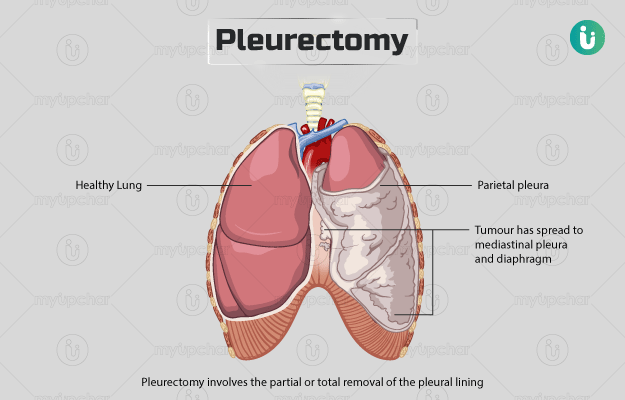Summary
Pleurectomy involves the partial or total removal of the pleural lining, which is the thin, moist layer between the lungs and the chest wall. This surgery is done to treat conditions like pneumothorax (air entrapped between the pleural layers) or cancer of the pleural lining (mesothelioma). You will need to abstain from food and drink from midnight before the surgery. The procedure will be done under general anaesthesia. After the surgery, you will be asked to take special care of the incision site and keep clean and dry until it heals. A follow up visit will be schedules about six weeks after the procedure to check your health.
- What is pleurectomy?
- Why is pleurectomy recommended?
- Who can and cannot get pleurectomy?
- What preparations are needed before pleurectomy?
- How is pleurectomy done?
- How to care for yourself after pleurectomy?
- What are the possible complications/risks of pleurectomy?
- When to follow up with your doctor after a pleurectomy?
What is pleurectomy?
A pleurectomy procedure is performed to remove a whole or portion of the pleura. Pleura is a thin, moist, double membrane between the chest wall and lungs. Its external layer is connected to the ribs and internal layer to the lungs. If you have air trapped in between these layers, it can push your lungs down. This condition is called a pneumothorax and can lead to difficulty breathing and collapsed lung.
This surgery will prevent lung collapse by allowing your lungs to remain attached to the chest wall.
Besides this, this surgery may be performed to increase the life expectancy of individuals with pleural mesothelioma (cancer of the pleural lining), which can lead to the accumulation of fluid inside the pleura (pleural effusion). To manage mesothelioma, the surgeon may use a combination of decortication (removal of the surface layer or membrane) and pleurectomy to remove the tumour cells from the pleural lining.
Why is pleurectomy recommended?
This surgery may be performed for the following conditions.
Pneumothorax: Symptoms of this condition include:
- Cough
- Chest tightness
- Feeling of stress, anxiety, and tension
- Rapid heartbeat
- Shortness of breath (short-term)
- Bluish dicolouration of skin
- Unexpected sharp pain in the chest that worsens on taking deep breaths or coughing
Malignant pleural mesothelioma: Malignant pleural mesothelioma occurs because of exposure to the mineral asbestos. Some of the symptoms associated with this condition are as follows:
- Persistent cough
- Chest pain
- Swollen fingertips
- Tiredness
- High fever and sweating, especially at night
- Shortness of breath
Who can and cannot get pleurectomy?
Your doctor may not perform this procedure if the cancer has spread from the pleural lining to the abdomen or contralateral hemithorax (e.g., the cancer from pleura on one side of the chest has spread to the other side).
What preparations are needed before pleurectomy?
The following preparations are needed before a pleurectomy:
- The healthcare provider will conduct a physical examination and ask you to undergo the following tests:
- Chest X-ray: A chest x-ray scan will help to examine your lungs and heart.
- Blood tests: These tests help to assess your overall health for the surgery.
- Echocardiogram (ECG): An ECG helps measures the electrical activity of heart.
- Ultrasound: An ultrasound scan will capture images of the organs inside your body. It helps to check for fluid buildup inside our lungs.
- Spirometry: It involves breathing inside the machine to check how much air you can inhale or exhale during the breathing process.
- Lung function tests: These tests help assess the lung capacity, i.e., the amount of air your lungs can hold.
- Magnetic resonance imaging (MRI)
- Computed tomography (CT) scan: An MRI and CT scan will give a three-dimensional image of the organs inside your body.
- You may need to fast starting from midnight before the surgery.
- The doctor may give you a nutritional drink before the surgery, which is to be taken three times a day for three days.
- Tell your doctor about all the medicines that you take. This includes prescribed and non-prescribed medications, herbs, vitamins, and supplements. If you are taking blood thinning medications like aspirin, vitamin E, ibuprofen, and warfarin, your doctor may ask you to stop taking them for a while before the surgery.
- If you smoke, you may be suggested to stop smoking for a few weeks before the surgery as it may otherwise delay healing and increase your risk of complications.
- Inform your doctor if you consume alcohol, especially more than one or two drinks a day.
- The doctor may not advise driving after the surgery. Hence, you will need someone, a friend or a family member, to drive you home after the surgery.
- You will need to sign a consent form, allowing the doctor to perform the surgery.
How is pleurectomy done?
The following steps are performed for the surgery:
- You will be asked to lie on your side on the OT table with your arms over your head.
- The anaesthetist (a specialist who administers anaesthesia) will give you general anaesthesia so you will be asleep during the surgery.
- Once you are asleep, the surgeon will make a cut on one side (affected side) of your chest to expose your lungs.
- He/she will use a special instrument called a retractor to separate your ribs.
- The surgeon will first cut the parietal pleura (outer membrane of the pleura) and the mediastinal pleura (pleura near the space between the two lungs).
- He/she will then carefully strip off both the outer and inner pleura.
- In mesothelioma, the surgeon may also remove tumour cells.
- If the tumor has spread to the diaphragm (a c-shaped thin muscle present below the lungs and the heart), the surgeon will remove the diaphragm too and reconstruct it artificially.
- Then, he/she will place in a chest tube to remove blood or manage the leakage of air from your lungs.
- Finally, the surgeon will close the cut using stitches.
It takes about an hour to complete this surgery. You will need a hospital stay of five to seven days.
After the surgery, the medical team will shift you to a recovery room, where you will be kept under observation. Once your vitals are stable, you will be moved to the medical ward. You will be given liquids through an intravenous (IV) line in your arm, and an oxygen mask will be provided to help you breathe smoothly after the surgery. This is usually kept overnight.
A nurse will give you medicines for relieving pain. The evening following the procedure, the medical staff will encourage you to sit and walk for a while to ensure better recovery and expansion of lungs. The chest tube will be removed once air leakage and drainage are stopped after the surgery. Once your chest tube is removed, you will be sent home.
How to care for yourself after pleurectomy?
At home, the following care is necessary:
- Wound care and bathing:
- It is normal to feel bruising, numbness, or soreness around the wound site for a while after the surgery.
- Make sure to keep the wound area clean and dry until it heals.
- You may be allowed to take a shower or bath as usual after the surgery. However, avoid rubbing soap on the wound or soaking the wound until it is healed.
- You must change the dressing on your wound site each day until the doctor asks you to.
- Medicines:
- The doctor will prescribe pain medicines to help you with post surgical pain.
- Activity:
- Your doctor may ask you to begin with light chores for two weeks after the surgery and avoid lifting heavy objects.
- He/she may suggest that you take up walking daily for for a quick recovery. Start with short distances and gradually increase.
- You may be able to resume work four to eight weeks after the operation.
- Work and Travel:
- Your doctor will inform you about when you can start working and driving again after the surgery.
- You may have to avoid air travelling for up to six weeks after the surgery.
When to see the doctor?
Call or visit your surgeon immediately if you are experiencing the following symptoms:
- Inability to eat or drink
- Blood in cough
- Difficulty in breathing
- Fever of 101°F or more
- Pus-like drainage from the wound site
- Swelling in neck, face, leg, or chest
- Pain even after taking medications
- Persistent cough with green or yellow-coloured mucus
What are the possible complications/risks of pleurectomy?
This surgery has the following risks:
- Subcutaneous emphysema (air leakage from the surrounding of the lungs into the skin)
- Bleeding
- Frequent fluid buildup in the chest cavity
- Damage to the diaphragm, food pipe, or air pipe
- Pneumonia
- Disturbance in heart rhythm
- Injury to the blood vessels or lungs
- Inability to expand lungs properly
- Pain
- Infection
When to follow up with your doctor after a pleurectomy?
You will need a follow-up meeting approximately six weeks after the surgery.
Disclaimer: The above information is provided purely from an educational point of view and is in no way a substitute for medical advice by a qualified doctor.
Surgery Cost In Your City
References
- Beth Israel Lahey Health: Winchester Hospital [Internet]. Winchester. Maryland. US; Pleural Effusion
- University Hospitals Bristol and Weston [Internet]. NHS Foundation Trust. National Health Service. UK; Pleurectomy
- Vlahu T, Vigneswaran WT. Pleurectomy and decortication. Ann Transl Med. 2017 Jun;5(11):246. PMID: 28706914.
- Murphy DJ, Gill RR. Overview of treatment related complications in malignant pleural mesothelioma. Ann Transl Med. 2017;5(11):235. PMID: 28706903.
- National Health Service [Internet]. UK; Mesothelioma
- Putnam JB. Lung, chest wall, pleura, and mediastinum. In: Townsend CM Jr, Beauchamp RD, Evers BM, Mattox KL, eds. Sabiston Textbook of Surgery. 20th ed. Philadelphia, PA: Elsevier Saunders; 2017:chap 57.
- Alfille PH, Wiener-Kronish JP, Bagchi A. Preoperative evaluation. In: Broaddus VC, Mason RJ, Ernst JD, et al, eds. Murray and Nadel's Textbook of Respiratory Medicine. 6th ed. Philadelphia, PA: Elsevier Saunders; 2016:chap 27.
- Feller-Kopman DJ, Decamp MM. Interventional and surgical approaches to lung disease. In: Goldman L, Schafer AI, eds. Goldman-Cecil Medicine. 25th ed. Philadelphia, PA: Elsevier Saunders; 2016:chap 101.
- Oxford University Hospitals [internet]: NHS Foundation Trust. National Health Service. U.K.; Surgery for Pneumothorax
- Liverpool Heart and Chest Hospital: NHS Foundation Trust [Internet]. National Health Service. US; Pleurectomy
- Guy's and St. Thomas' Hospital: NHS Foundation Trust [Internet]. National Health Service. UK; Recovery after lung surgery
- Dexter EU. Perioperative care of the thoracic surgical patient. In: Selke FW, del Nido PJ, Swanson SJ, eds. Sabiston and Spencer Surgery of the Chest. 9th ed. Philadelphia, PA: Elsevier; 2016:chap 4.















